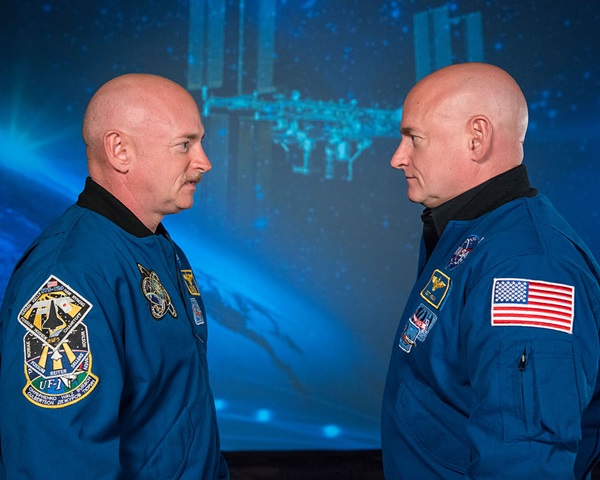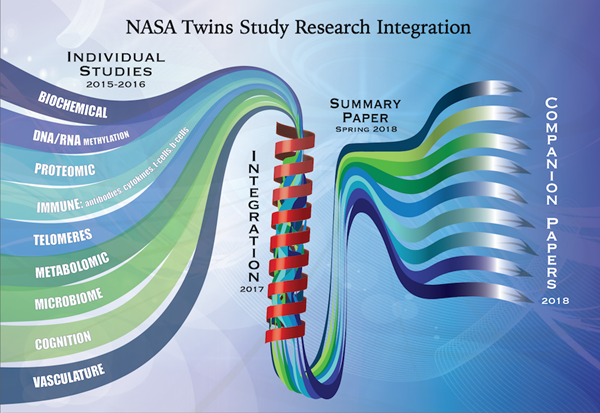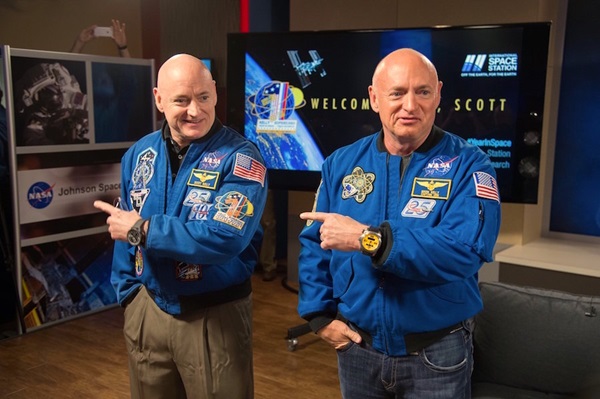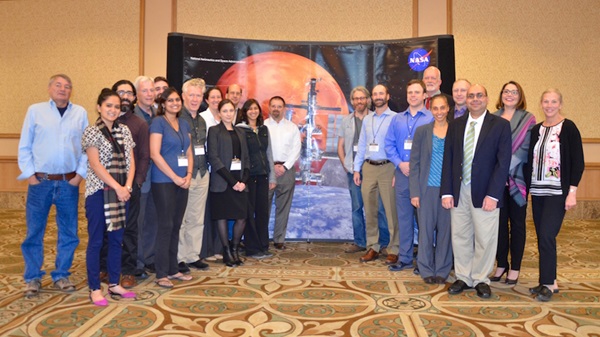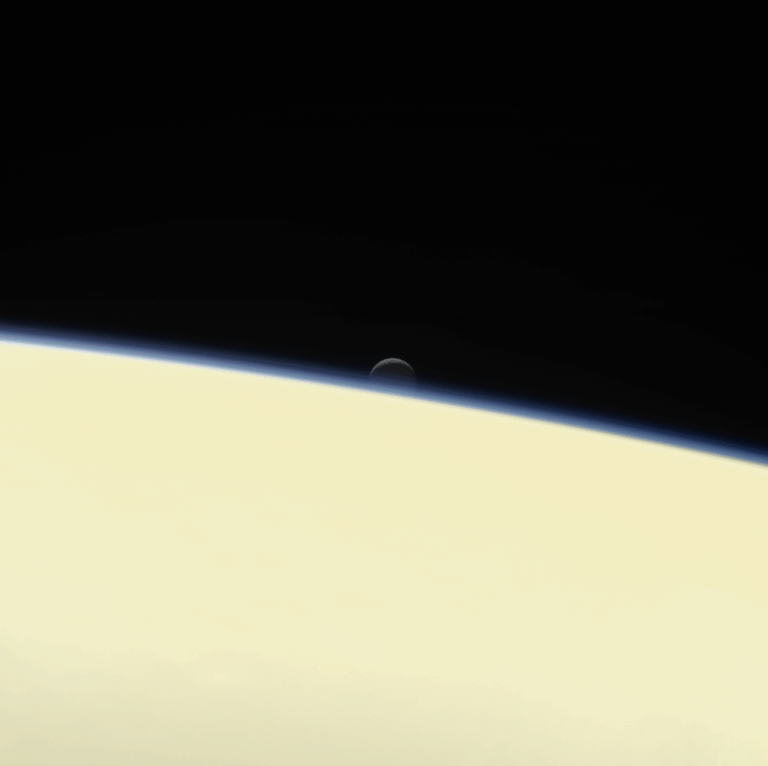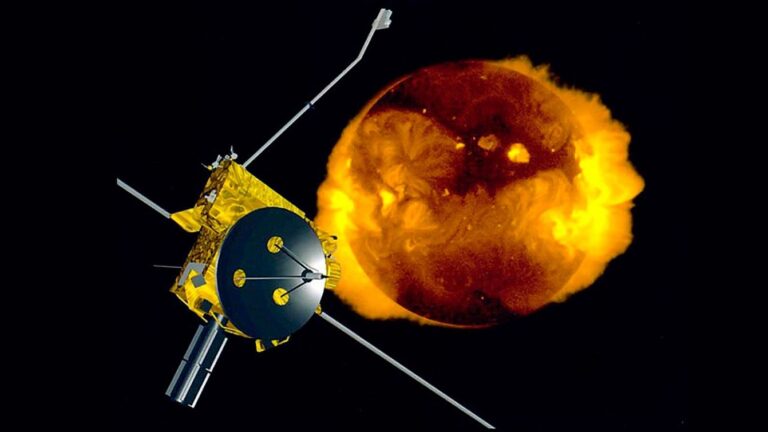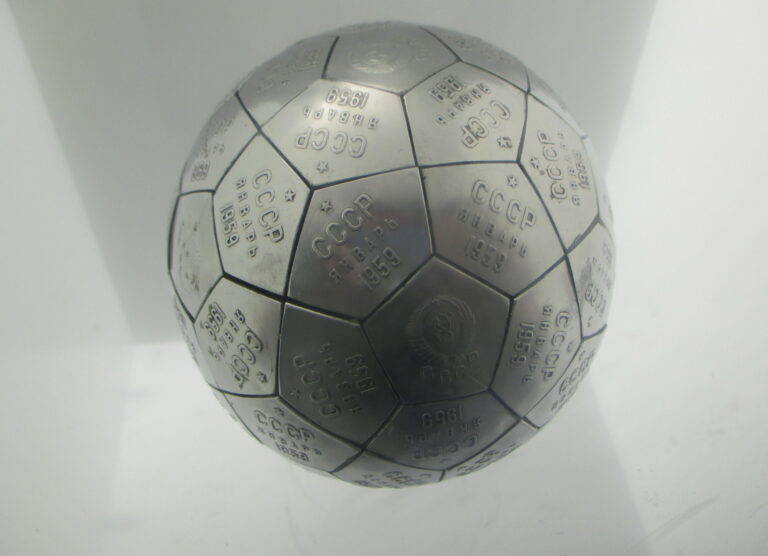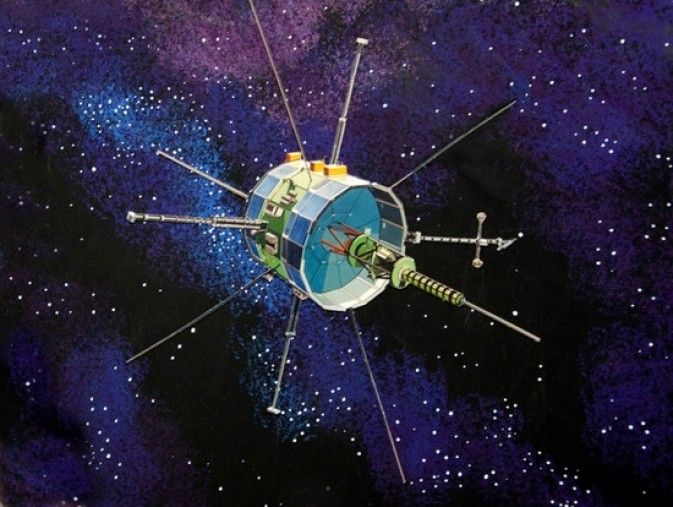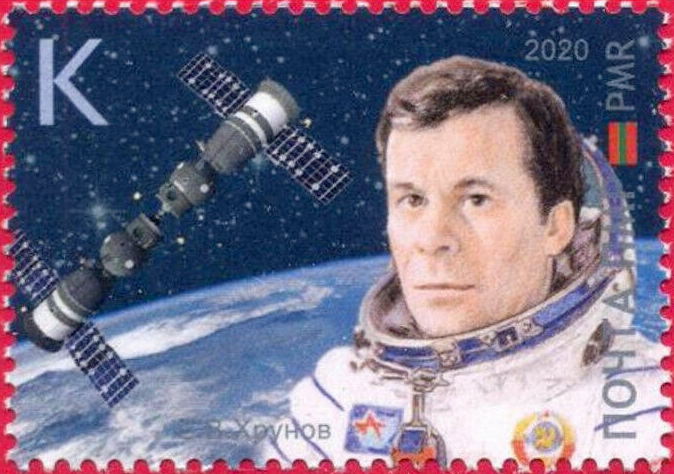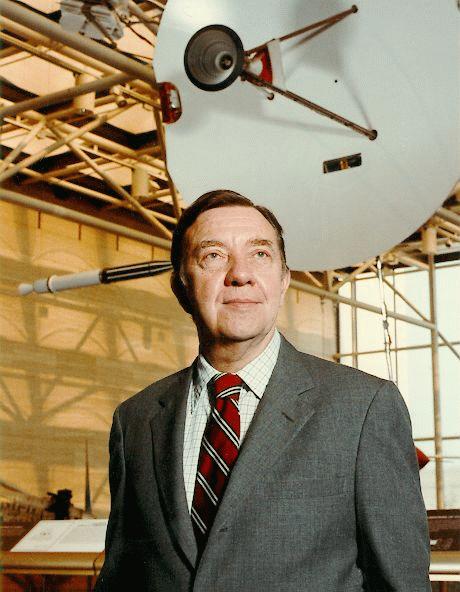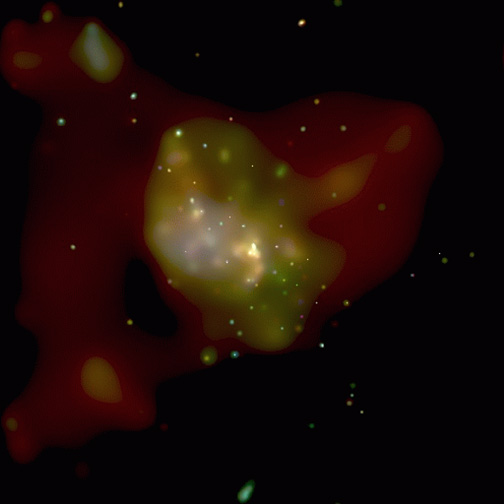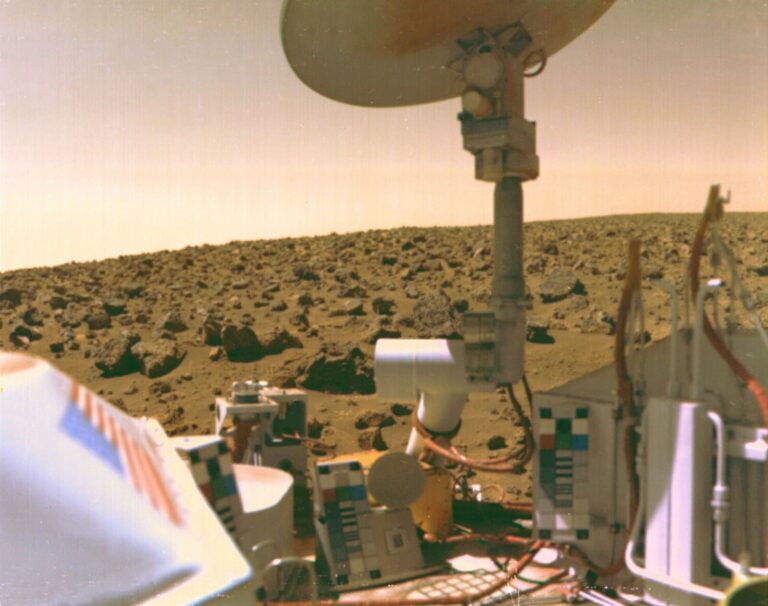Key Takeaways:
Scott and Mark Kelly are identical twin brothers. Though that alone does not make them unique, what does is the fact that they are also both astronauts. In order to take advantage of the Kellys’ unique situation, NASA scientists decided to conduct a detailed study on the twins, aimed at unraveling how nature versus nurture plays out in space.
As part of NASA’s Twins Study, researchers collected biological samples from each of the Kellys before sending Scott to the International Space Station for a year starting in March 2016. Meanwhile, his brother Mark, who retired as an astronaut in 2011, remained on Earth to serve as the control subject. By analyzing how each twins’ biological markers evolved during the mission, the researchers learned a great deal about how the human body reacts — both physically and mentally — to extended periods of spaceflight.
The NASA Twins Study is made up of ten distinct research projects, which all focus on different aspects of the human body. And last month, after nearly two years of study, the ten separate research teams confirmed their preliminary findings (which were initially released in 2017), as well as presented details on their postflight follow-up results.
Later this year, the findings for each of the various projects will be integrated together and released as one summary paper, which will be followed by several companion papers focusing on the individual studies. In the meantime, here is a summary of the most recent findings for each of the research projects that were carried out as part of the Twins Study.
Telomeres are the caps that shield the ends of our chromosomes, protecting DNA strands from damage and degradation. In a study led by Susan Bailey of Colorado State University, researchers tracked the length of each twins’ telomeres before, during, and after Scott’s yearlong spaceflight.
The researchers found that Scott’s telomeres significantly increased in length while he was in space, which was not the case with his Earth-bound brother Mark, whose telomeres remained relatively stable. Previous research has shown that longer telomeres are associated with fewer age-related problems.
Though Scott’s telomeres were found to lengthen while he was in space, postflight measurements showed that the telomeres underwent rapid shortening within about 48 hours of landing back on Earth. Eventually, they returned to their preflight lengths. The team believes that the temporary lengthening of Scott’s telomeres could be a side effect of his rigorous exercise routine and restricted, low-calorie diet.
#2 – Decreased body mass and increased folate in orbit
A study conducted by Scott M. Smith of the NASA Johnson Space Center monitored the biochemical profiles of each twin to identify any changes. To do this, his team tracked the brothers’ heights and weights and analyzed their blood and urine samples throughout the duration of the mission.
The researchers not only found that Scott’s body mass noticeably dropped during his time in space, but also that his levels of folate — a beneficial form of folic acid often used to treat anemia — significantly increased.
Much like Bailey’s findings on telomere lengthening, Smith believes the drop in body mass and increase in folate could simply be a result of eating healthier and exercising more often.
#3 – Mentally fit in space, foggy back on Earth
Mathias Basner of the University of Pennsylvania conducted a study that monitored the cognition of both twins over the duration of the mission. By requiring each twin to perform ten different cognitive tests multiple times (preflight, inflight, and postflight), the researchers were able to track how spacefaring Scott’s mental faculties were affected by microgravity.
Using the preflight test results as a baseline, Basner found that Scott’s yearlong mission aboard the ISS did not significantly impair his cognitive abilities while inflight. However, when Scott returned to Earth, the researchers did detect a more pronounced decrease in his speed and accuracy on cognitive tests.
The researchers believe that readjusting to Earth’s gravity may be the cause of Scott’s postflight cognitive decline, but further study is needed to confirm. They also point out that Scott’s performance could have suffered when returning to Earth as the result of a very hectic postflight schedule.
#4 – Flu vaccine stimulates immune system, even in space
To investigate how space affects a human body’s immune system, Emmanuel Mignot of Stanford University conducted a study that introduced the flu vaccine to Scott and Mark on two separate occasions spaced one year apart — during preflight and postflight.
On both occasions, after the vaccines were administered, the twins displayed similar increased immune cell responses to the flu. When the human body is vaccinated against the flu, weakened or dead flu virus cells are injected into the bloodstream. This triggers the body to produce antibodies that seek out and destroy the viral cells, thus preventing any healthy flu cells from multiplying and overwhelming the body’s defenses.
Because the twins showed similar immune responses to both vaccinations, the researchers concluded that being in space does not prevent the flu vaccine from producing the desired immune response.
#5 – Inflammation increases while in space
Mike Snyder of Stanford University carried out a study that investigated whether or not space affects inflammation in the human body. Using blood tests to measure lipids (fats) and cytokines (proteins in the blood that serve as well-known indicators of inflammation), Snyder was able to compare how the inflammatory responses of the brothers differed while Scott was in space.
In this study, the researchers found multiple lines of evidence suggesting that Scott’s body was more prone to inflammation in a microgravity environment than Mark’s was on Earth. For one, the researchers found that Scott had altered levels of a lipid panel taken in space, indicating increased inflammation in his body. The researchers also noted that a certain group of Scott’s cytokines were found to be elevated before the flight, and they remained elevated throughout the mission. Furthermore, another group of Scott’s cytokines spiked just after he returned to Earth. This group of cytokines remained elevated for six months.
Additionally, the study showed that Scott’s body experienced an increase in some proteins that are known to help regulate normal insulin activity. Since inflammation can cause insulin resistance, the increase in Scott’s proteins may have been a counter-measure executed by his body to help combat the insulin resistance associated with inflammation.
Inside of each of our guts lives a vast community of microorganisms, known as the microbiome, which plays an important role in our overall health. To study how living in a microgravity environment impacts the microbiome, Fred Turek of Northwestern University monitored the state of each twin’s microbiome before, during, and after the yearlong mission.
The researchers found that the microbiomes of both Scott and Mark were drastically different at all times throughout the project, but the differences were somewhat expected considering microbiomes are very sensitive to environmental variances such as diet and individual immunity. However, the researchers point out that Scott’s microbiome was different in space than it was preflight, displaying a decreased presence of one branch of bacteria known as Bacteroidetes. However, these changes did not persist upon Scott’s return to Earth.
Even though the study showed that Scott’s microbiome changed when switching settings between Earth and space, the changes that were observed were similar to those that would be expected if someone on the ground significantly modified their diet or was exposed to a new environment.
#7 – Spaceflight can trigger gene mutations
Chris Mason of Weill Cornell Medicine used the Twins Study as an opportunity to investigate how space travel can influence genetics. By looking for chemical changes in RNA and DNA through the use of whole-genome sequencing, the researchers showed that Scott experienced hundreds of unique gene mutations compared with his twin.
Though some distinct gene mutations were to be expected, even in twins, the sheer amount of changes surprised the researchers. A few of the gene changes, which were discovered only after Scott returned to Earth, were even found on cell-free DNA and RNA that was circulating in his bloodstream. The researchers believe that these gene changes resulted from the stresses of space travel, which can alter the biological pathways within cells, causing them to eject DNA and RNA. These free-floating DNA and RNA molecules can then trigger the production of new fats or proteins, or even turn specific genes on and off. Though 93 percent of the genes that expressed themselves differently while Scott was in space returned to normal postflight, the researchers found a subset of several hundred “space genes” that remained disrupted after his return.
Of the many gene-induced changes Scott’s body experienced, the researchers found five to be of particular relevance for future missions: (1) Hypoxia, which was likely caused by a lack of oxygen and a surplus of carbon dioxide; (2) Mitochondrial stress and increased levels of mitochondria in the blood, which suggests damage was done to the “power plants” of cells; (3) Telomere lengthening, DNA repair, and DNA damage, which could be a result of living a healthy lifestyle while constantly exposed to radiation; (4) Decreased collagen production, blood clotting, and bone formation, which was likely a combined result of living in microgravity and of fluids shifting around within the body; and (5) Hyperactive immune activity, which may be an effect of living in a new environment.
#8 – Living in space changes how genes are expressed
Similar to the previous project, Andy Feinberg of Johns Hopkins University conducted a study that tracked how each of the twins’ epigenetics (the way that genes express themselves) differed based on their environment.
In two separate populations of white blood cells, Feinberg found multiple regions of the genome where DNA methylation — the process responsible for turning genes on and off — had occurred. These chemical modifications to Scott’s genome were found near two interesting regions. One was close to a gene known to help regulate telomere growth, and another was found near a gene related to collagen production.
Although Scott did experience epigenetic changes during his time in space, the researchers found that the majority of changes were within the expected range of variability for his twin on Earth. However, the results related to telomere growth and collagen production are consistent with the findings of other Twins Study projects.
#9 – Artery walls thicken while in space
Stuart Lee of KBRWyle at NASA Johnson Space Center’s Cardiovascular and Vision Lab performed a study on how inflammation and oxidative stress (damage by free radicals in the air) can impact the structure and effectiveness of arteries. To do this, the researchers examined the twins’ arteries using ultrasound, as well as collected blood and urine samples throughout the mission.
Both during and immediately after the mission, the researchers found that Scott’s inflammation biomarkers were elevated and that the wall of his carotid artery was thicker than it was preflight. Neither of these changes were seen in Mark during his stay on Earth.
At this point, the researchers do not know whether the thickening of Scott’s carotid artery is a temporary and reversible adaptation to living in space, or if it is evidence of permanent and premature arterial aging. Further study is needed to put these findings into clearer focus.
#10 – Proteins that regulate fluids increase while in space
In order to investigate how spaceflight impacts the body’s ability to form and modify proteins, Brinda Rana of the University of California carried out a study that collected urine samples from Scott and Mark before, during, and after the mission. This allowed Rana to identify certain biomarker proteins that are associated with space-related bodily changes, such as muscle and bone loss, metabolic and cardiovascular changes, and the altered regulation of fluids within the body.
The researchers found that while Scott was in space, he excreted some proteins at different concentrations than his Earth-bound brother Mark. In particular, Scott had elevated levels of a protein called aquaporin 2, which helps form the pathways used to carry water through cell membranes in the kidneys. Because aquaporin 2 helps regulate how water is transported within the body, it also serves as a valuable indicator of a body’s overall hydration status.
Notably, the researchers also found that Scott’s increase in aquaporin 2 during spaceflight was correlated with higher levels of plasma sodium — an indicator of dehydration. Though further study is needed, the researchers believe that the increase in aquaporin 2 and plasma sodium may be tied to fluids shifting throughout Scott’s body while he was in a microgravity environment. This is important because, as has been documented with other space-bound astronauts, fluids tend to migrate to the head, causing visual impairment and intracranial pressure.
By taking advantage of an extremely unique opportunity, NASA’s Human Research Program has carried out the first genomic evaluation of the potential risks the human body faces during extended periods of spaceflight. While the results of NASA’s Twins Study are far from conclusive — the sample size is one set of twins and not every variable was strictly controlled for — the study does provide researchers with a wealth of data to guide future studies on the risks of human spaceflight.
As NASA said in a press release, “observations guide development of future hypotheses,” and NASA’s Twins Study has taken the first step to observing how our genomic blueprint is affected by long-term exposure to microgravity and an increased radiation environment. With the information collected as part of this medley of studies, NASA has the preliminary data it needs to inform countless more projects for years to come.
In the meantime, make sure to check back later this year when NASA releases its Twins Study summary paper, which will integrate the results from all ten of the individual studies. Shortly thereafter, each individual study will be releasing its own companion paper.
Twins Study Principal Investigator Chris Mason discusses how gene expression is affected by zero gravity.
NASA

